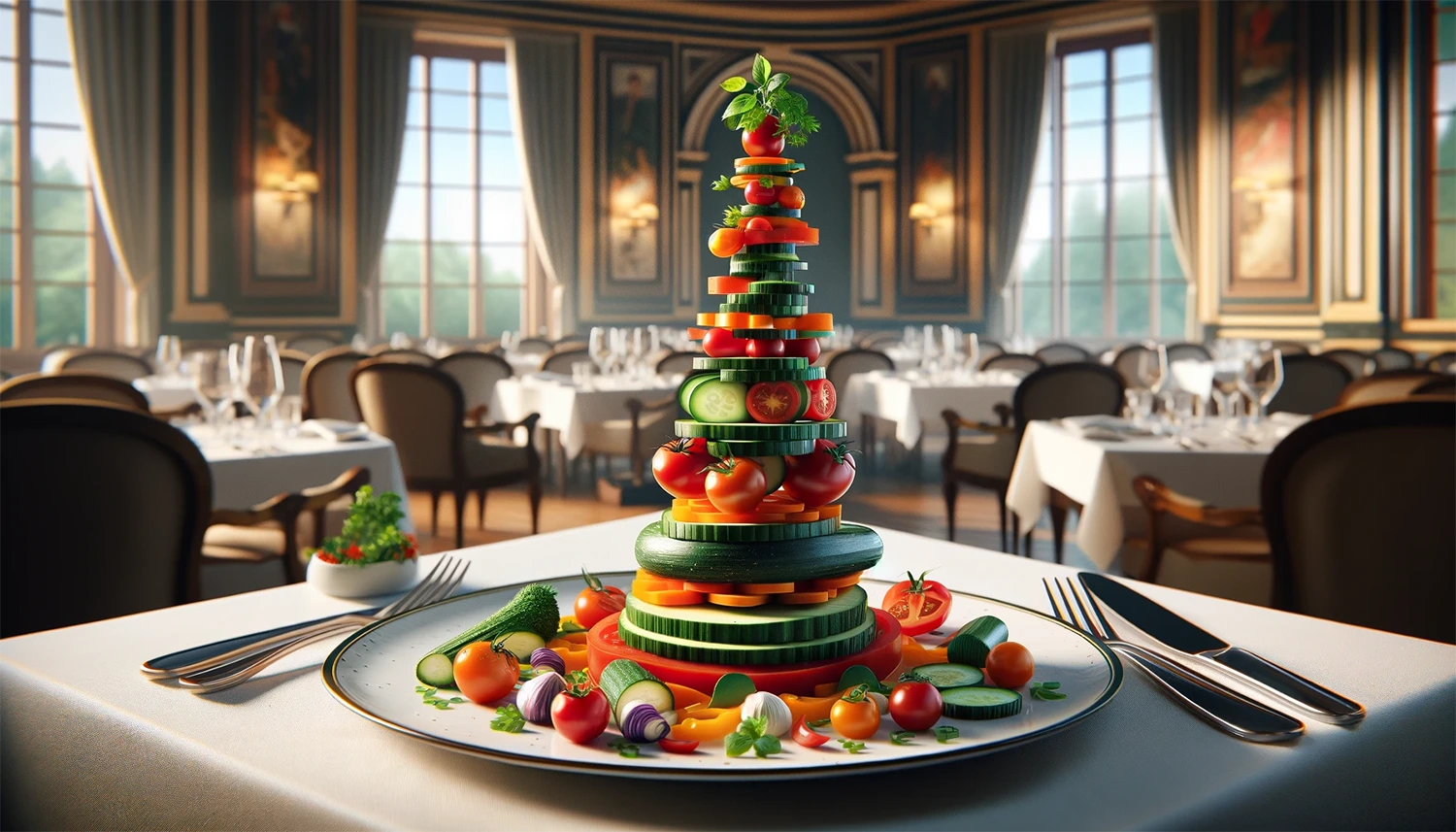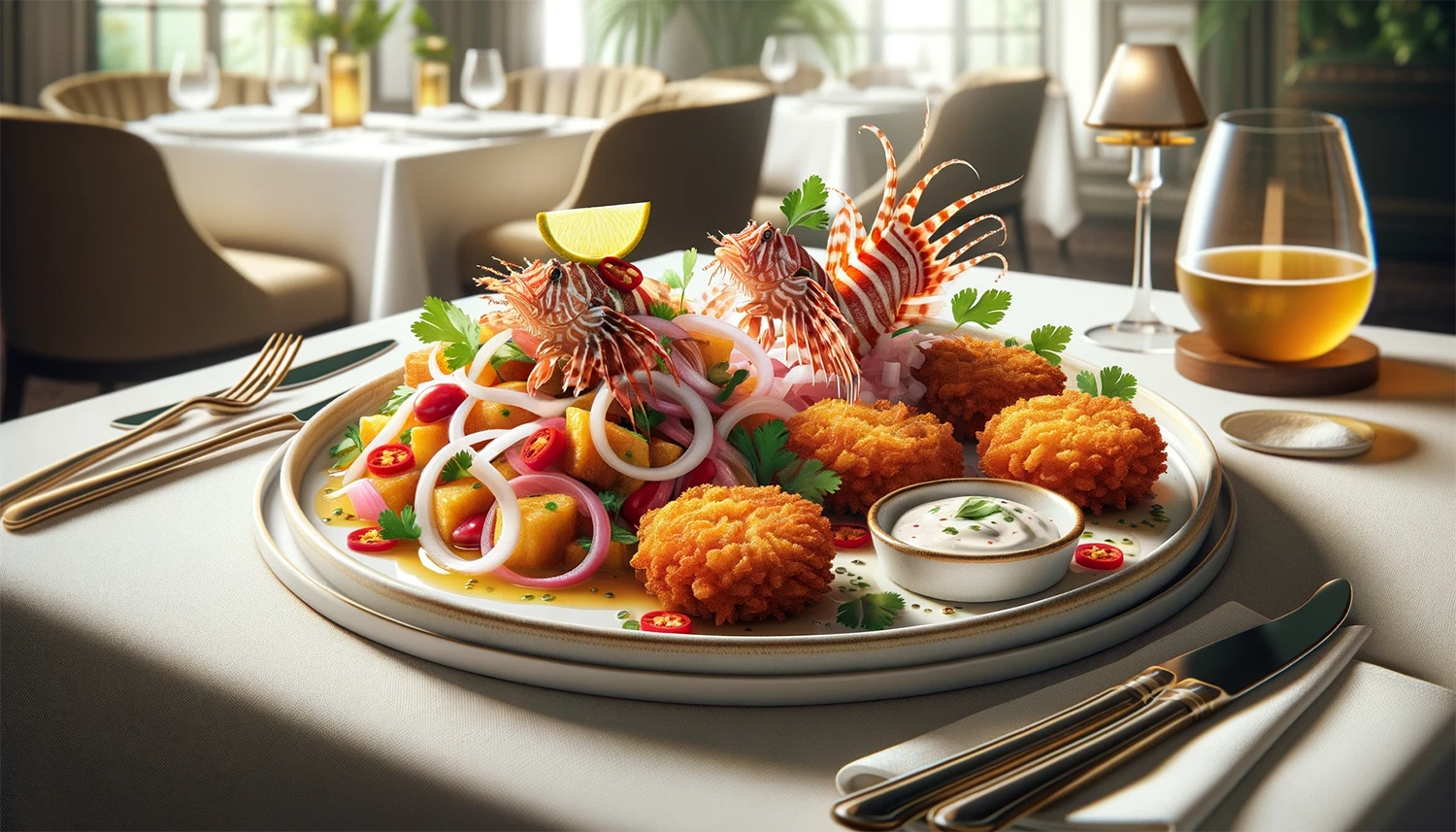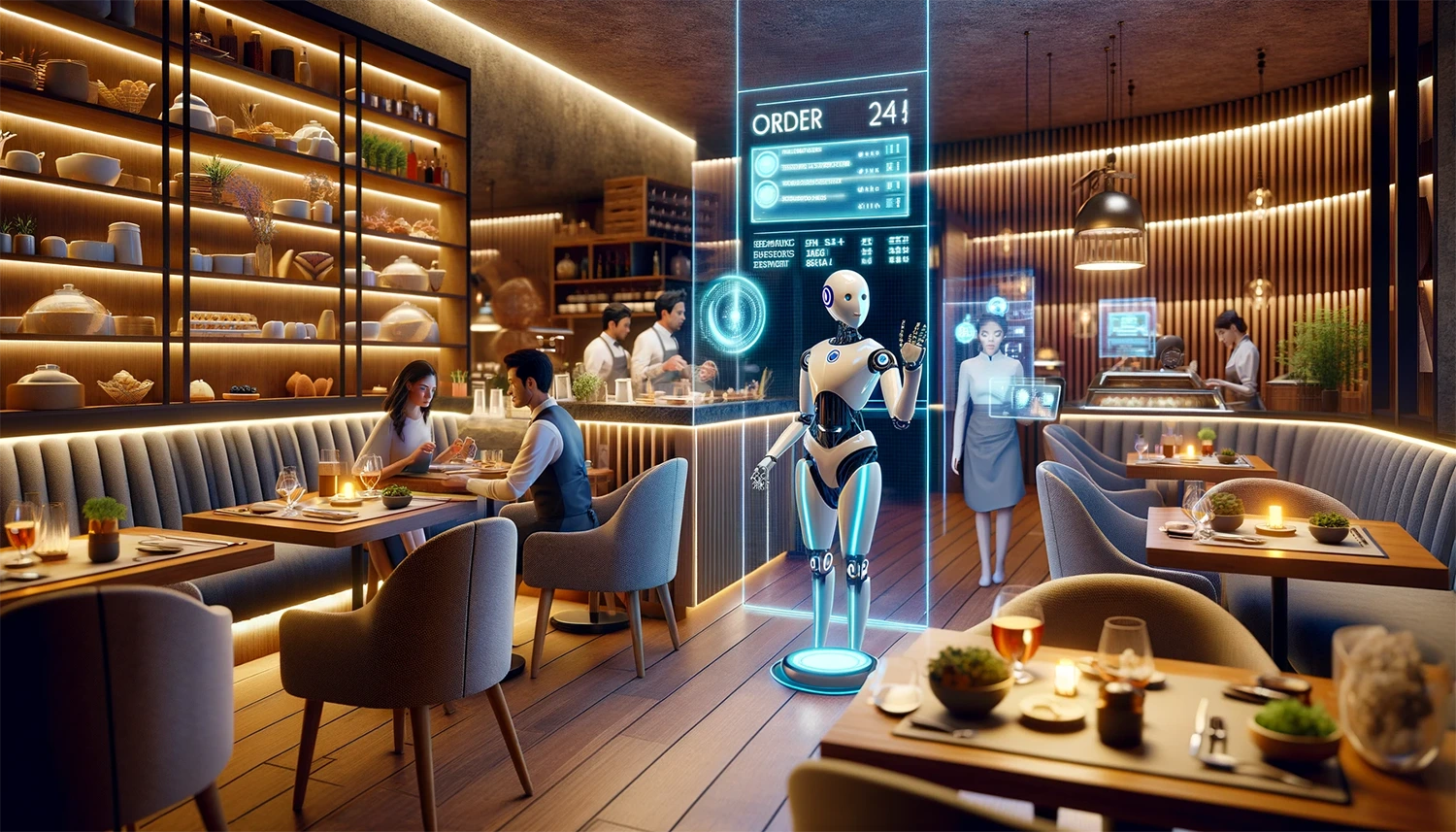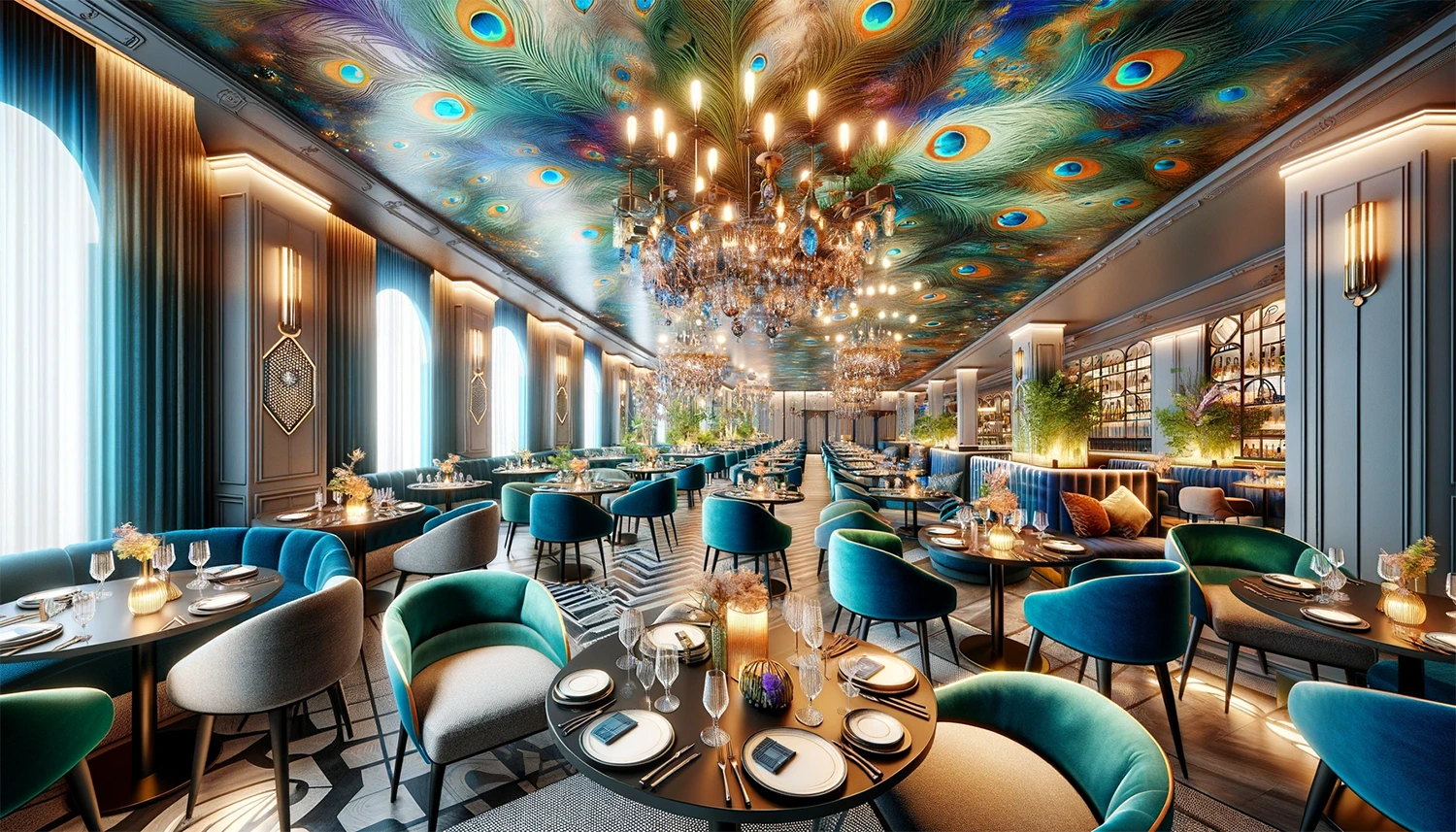Another year is over, and another crop of food and hospitality prophecies from the crystal ball gazers at af&co. and Carbonate is in. Their 2024 Hospitality Trend Report has identified more than 30 rising currents across five categories: Design, Drinks, Food and Menu Innovation, Technology, and Collaborations.
In this post, we’ve distilled the research down to 10 key trends we think you should have on your radar going into 2024.
Let’s dive right in.
1. Embrace the maximalist spirit
DALL-E 3’s vision of maximalist design
When it comes to restaurant design, minimalism is out, and maximalism is in. We’re talking vibrant colors, rich textures, eye-catching graphics, and theatrical presentations that play with negative space. It’s a more-is-more attitude that fully embraces excess from floor to ceiling to table.
Nubeluz’s aptly named Peacock Lounge in New York is a great example, wrapping guests in deep pinks and peacock blue velvets. So is Bar Sprezzatura in San Francisco, where the dining room pops with ornate gold borders and custom illustrations. Both are stunning examples of over-the-top style done right.
Leaning into maximalism is a chance for you to create an Instagrammable interior that plays up the dining experience as entertainment. It signals that you don’t take yourself too seriously while appealing to younger demographics looking for a lively, social atmosphere.
When you design your maximalist dining room, don’t hold back on colors, textures, graphics, and embellishments. Paint a bold mural, dress banquettes in vibrant velvets, or add tropical wallpaper. Then, set the table with floral centerpieces and ceramics with dramatic silhouettes. The goal is sensory overload—but in the best way possible.
Use your food as an opportunity to embrace maximalism, too. Try experimental plating techniques. Tower ingredients precariously. Sprinkle dishes with edible glitter and gold dust, or opt for tableside preparations for an added dose of dinner theater.
Most importantly, let your maximalist interior set the stage for an equally bold, innovative dining experience. Your guests will eagerly fill their feeds with photos capturing your maximalist world.
2. Cross culinary borders
DALL-E 3’s vision of an Afro-Filipino dish
Fusion cuisine is so yesterday. Today, artful cross-cultural cooking rules the plate. Diners crave adventure, and combinations like Afro-Filipino or Mexican-Lebanese cuisines deliver intrigue in every bite while reflecting America’s melting pot.
At Mahal BBQ in Washington DC, chef Tom Cunanan marries Filipino flavors like longanisa sausage and hearty bibingka cornbread with coconut braised greens and smoked chicken rubbed in annatto and lemongrass. Fatima’s Grill has gone viral in Southern California for over-the-top Halal Mexican Mediterranean mashups like shawarma crunch wraps.
Cross-cultural cooking helps you stand out from the usual suspects in your neighborhood. Start by brainstorming fusions that blend cuisines from different regions of the globe. For instance, if you operate an Italian eatery, consider adding Korean gochujang heat to your Bolognese sauce. If Chinese fare is your specialty, consider adding the flavors of Mexico to a stir fry.
Don’t limit yourself to geographical borders, either. Explore combinations of smoky and spicy or sweet and herbal flavor profiles. A combination that seems strange enough to work might become your signature dish.
The adventurous spirit behind cross-cultural cooking is also great for marketing your restaurant. Share the inspirations and stories behind your fusion dishes on social media and your website to attract foodies. Photos of ingredient mashups will capture their attention in feeds.
Ignore preconceived notions of what certain cuisines “should” taste like. In cross-cultural cooking, you’ll find plenty of uncharted flavor frontiers left to explore.
3. Sculpt the tablescape
DALL-E 3’s representation of a towering plate of vegetables
Forget the tidy triangle. Plating has become an art form. Sculptural arrangements that play with height, color, and negative space are in. Plates with round rims are no longer enough. Creative chefs use handmade vessels with ruffled edges, ear-shaped handles, and speckled glazes.
To create gorgeous tables that complement your culinary vision, let dishes capture attention as they offer the dishes you serve. For example, a crescent moon plate sits atop a bed of desert sand and sprouting wildflowers at Arizona’s Ambiente Landscape Hotel. At Gary Danko’s in San Francisco, a precarious tower of vegetables raises eyebrows. Dramatic yet harmonious presentions like those turn dining into performance art.
Stylized plating also lets you showcase seasonal ingredients and themes. Offer summer’s bounty with an array of heights and colors. Echo the autumn harvest with rich stews in terracotta platters. And brighten winter days with whimsical presentations that use negative space.
Look for ceramicists and potters whose avant-garde designs will make your ingredients pop. Source speckled plates, leaf-shaped bowls, oblong platters, or wooden slabs. Then, create compositions that balance, juxtapose, mimic, or defy the vessel’s form. Aim for drama mixed with purpose to amaze and wow your diners.
4. Blend the bar and kitchen
DALL-E 3’s vision of a roasted tomato and basil Caprese martini
The days of sweet and boozy cocktails have given way to a new era of culinary libations. Today’s avant-garde bartenders are raiding the kitchen for inspiration, using ingredients and techniques that complement small, shareable plates. We’re talking roasted tomato and basil Caprese martinis, mezcal and goat cheese combinations, or spirits fat-washed with last night’s brisket drippings.
The Felix in San Francisco stirs up brilliance with its Pho Wimme, made with rye washed in leftover pho tallow and spiked with benedictine and mole bitters. In Chicago, Lazy Bird delivers a blend of mezcal and apricot with creamy goat cheese in its Delhi.
Culinary cocktails let you eliminate waste through upcycling while showcasing your kitchen’s talents at the bar. Start by taking inventory of what creative potential lies in your walk-in. Transform leftover corn husks into a smoky mezcal tincture or infuse vodka with charred lemongrass scraps. Repurpose the oily drippings from last Tuesday’s 55-day, dry-aged ribeye into a mouthwatering fat-washed bourbon.
Culinary cocktails also allow you to echo or contrast flavors from small plates. Does your menu offer a compressed watermelon salad with feta and lime? Try muddling those same components into vodka or gin. Feature a sweet and spicy dragon fruit curry? Balance the heat with a dragon fruit and coconut-cream frozen daiquiri.
Most importantly, give your bartenders the creative license to wander beyond traditional flavor profiles. Let them explore inspiration from the kitchen. The “chef’s table” now lies behind the stick, with conversational cocktails that weave liquid storytelling into your food program and turn your bar into its own dinner theater.
5. Reinvent classics
DALL-E 3’s representation of shrimp toast with candied walnuts
While novelty shines brightly on many menus today, reinvented classics are starting to light up the dining scene. Clever chefs, breathing new life into old favorites, are elevating nostalgic dishes like shrimp toast appetizers or Eton Mess desserts. These classics reborn strike a perfect balance between familiarity and intrigue.
Once relegated to Chinese menus, shrimp toast is going gourmet and global thanks to new interpretations. See the truffled-up version stuffed into little rolls at New York’s C as in Charlie or the toast topped with candied walnuts and burnt honey mayo at San Francisco’s Piglet & Co.
Similarly, the British Eton Mess now has meringue cousins across continents. Find versions made with sesame at KIN in Idaho, sweet corn and chamomile ice cream at California’s PRESS, or rhubarb sorbet zabaione kisses with poached fruit at Jupiter in New York.
Although the trend says that you should experiment with the latest food trends, anchors like nostalgic classics reborn can also work magic. They attract tradition-seeking patrons while showing your creativity through small but mighty touches.
Start by identifying menu classics ripe for reinvention. How might you give your burger, pizza, pasta primavera, or fruit crisp an upgrade that excites diners? Source high-quality ingredients as your base, like dry-aged beef or heirloom tomatoes, for a memorable flavor payoff. Then, get creative with mix-ins, garnishes, and modern cooking techniques while holding onto the dish’s essence.
To add a final twist, plate reborn classics with an artistic flourish or a striking color combination that dazzles the eye as much as the palate. Your inventive trip down memory lane will have guests reminiscing long after the last bite.
6. Serve up beverage adventures
DALL-E 3’s vision of a wine tree
Sommeliers are striking the perfect balance between comfort and adventure when designing wine programs today. While you can attract trend-seeking wine connoisseurs with obscure orange wines and funky natural gems, you can also encourage people to relax with fruit-forward chilled reds. These crisp, round wines are refreshing on hot summer nights and provide an unintimidating on-ramp for younger generations.
Consider how One Market Restaurant in San Francisco divides its wine list into “Chilled Reds” and “Reds,” validating this departure from convention. Their selection, from properly cooled Italian Primitivos and juicy Grenache blends, maximizes brightness and drinkability.
For an added touch of flair, some restaurants present wines in custom “trees”—tiered glass cylinder holders that allow servers to deliver multiple glasses in one showstopping tower. Boston’s Mariel restaurant uses trees to offer guests three Daiquiri options, which adds a festive element when serving large parties.
If you’re looking to add a touch of adventure to your wine list without giving up comfort, start by tasting potential chilled red additions with summer in mind, whether a Spanish Mencia, California Zin, or silky Pinot Noir. Prominently display your chilled wine options on your menus and tables. If you sell bottles or flights to larger groups, consider splurging on custom glass trees to wow your guests. When you use trees consistently, the memorable presentation will become a signature for your brand.
7. Restore through your restaurant
DALL-E 3’s representation of lionfish ceviche
Sustainability remains an urgent calling for restaurants today. Locavore sourcing has become table stakes. So, what’s next for operators who want to walk the talk of environmental stewardship? Trailblazing restaurateurs are now turning their efforts toward actively restoring regional waters and ecosystems damaged by invasive species.
Venice’s Michelin-starred Venissa has pioneered “environmental cuisine” to champion the cause. Dishes like blue crab cakes and pasta honor the Venetian lagoon’s native inhabitants while helping to control aggressive newcomers. Across the Caribbean, Finz by D Sea offers lionfish ceviche and fritters to stop the predators from destroying coral reef life.
If you’re committed to sustainability, consider promoting invasive species to capture guests’ attention while reaffirming your values through action. Partner with local fishermen to help control populations and highlight your dedication through your cuisine. Incorporate invasive finds into menus with a badge or callout highlighting their environmental upside.
Consider giving patrons a reason to get in on the action, too. The Bahamas’ Caerula Mar Club offers a free cocktail to guests who collect one bag of beach trash. At California’s Rush Creek Lodge near Yosemite National Park, visitors who join the annual park cleanup earn a complimentary wildflower foot soak.
Backed by creative incentives, your dedication to being an agent of environmental change allows your community to participate in the future of food sustainability—an effort diners are eager to support through their patronage.
8. Welcome your AI assistants
DALL-E 3’s rendering of a restaurant using AI
The age of artificial intelligence has arrived, and restaurants that fail to embrace its potential risk getting left behind. From traffic forecasting and inventory to marketing and personalized menus, AI promises to revolutionize restaurant operations and the dining experience.
For instance, brands are now using AI to track inventory in real time. By monitoring everything from what’s in the walk-in to weather and local events, technology can help you predict demand spikes and lulls well in advance. Predictive ordering could transform your restaurant, especially if you hate wasting product and disappointing guests.
Menus are also a prime playground for adding AI. The Stellar Menus Intelligent Menu Platform helps you protect your margin and price your menu for maximum profit by identifying the cost-driving ingredients of each dish, monitoring the market to watch for changes in those costs, and then sending you alerts when it’s time to consider changing your prices. The platform also makes it easy to change prices across your digital and print menus with just a few clicks of the mouse. If you’d like to see how it works, request a demo.
If you use AI wisely, you can punch above your weight class, compete with larger establishments, and give your guests exceptional, personalized experiences.
9. Tap customer loyalty programs
DALL-E 3’s representation of a restaurant filled with loyal patrons
Loyalty programs are no longer exclusive to large hotel chains and airlines. Finally, new technology platforms allow independent restaurants like yours to encourage devotion from your most passionate supporters.
These tools, designed for smaller operators, use customizable mobile apps that integrate just about everything—online ordering, reviews, automated marketing, and detailed customer records. They allow your branded program to reward diners through points-based systems or status tiers with exclusive perks. The more diners spend and engage, the more VIP treatment they get.
Atlas Restaurant Group has successfully used this model across its properties in Baltimore, Maryland. Their app encourages visits to different locations and offers early access to new menu launches and wine dinners to encourage top-tier members to dine even more.
If your resources are already stretched thin, consider teaming up with other neighborhood eateries to create a shared loyalty program under a local collective dining brand. Joint marketing efforts can help each participating restaurant reach new audiences while making participation more affordable. Just be sure to highlight member benefits when you advertise the program. The more value you can show up front, the faster those sign-ups and downloads will happen.
10. Offer collaborative cuisine
DALL-E 3’s vision of a pop-up shop on a rooftop bar
Creative collaborations are stealing the spotlight in the experience-driven dining scene, where restaurants become cultural connectors through efforts like mashup dinners with guest chefs, product stunts with celebrities, and cross-industry events. Shared values provide the connective tissue for these partnerships between brands whose ethics and aesthetics mesh. When done thoughtfully, such collaborations feel authentic rather than promotional.
Uchiko restaurant in Austin hosts a collaborative Kolache residency, inviting chefs from area eateries to create limited-edition stuffed pastries for its bakery. The monthly rotations consistently generate buzz and forge community ties.Grayscale, an emerging sustainable clothing brand, occasionally opens a pop-up shop on the rooftop bar of Broken Shaker Miami.
In the packaged space, ice cream darling Jeni’s Splendid recently teamed with pop star Olivia Rodrigo in honor of her second album. Co-designed flavors, listening parties, and swag amplified both artists’ alternative brand images among young consumers.
Which potential collaborator brands could introduce your concept to new demographics? A start-up alcohol brand looking for on-premise visibility would welcome your interest—while providing ingredients for a custom cocktail. A local pottery studio could provide ceramic works to display your homemade bread and pastries.
Explore the creative synergies that might exist in your community. And don’t fear being rejected by brands that inspire you. The right collaboration partner will welcome a bold outreach. Remember, quality over quantity will serve you and your patrons best. Even one thoughtful team-up each year will keep your audiences engaged and rooting for your continued growth together.
What’s next? Warm wishes for a trendy, profitable 2024
DALL-E 3’s vision of beautiful restaurant in peacock hues
As we wave goodbye to 2023 and look ahead to brighter horizons, the trends in the 2024 Hospitality Trends Report point to a future filled with spirited maximalism, boundary-pushing flavors, inventive presentations, and values-driven efforts that delight diners while moving the hospitality industry forward.
We hope the examples and advice in this post sparked your imagination and will help prepare your restaurant for the next big consumer wave. Today’s guests want tastebud satisfaction. But tomorrow’s want captivating experiences that dazzle the senses, bring people together, and promote positive change.
Delight and surprise guests by embracing what’s new and what’s next. The suggestions here are just sparks—the possibilities lie in how you choose to fan the flames when your doors open. Here’s wishing you delectable dishes, dazzling spaces, and a profitable 2024.
















